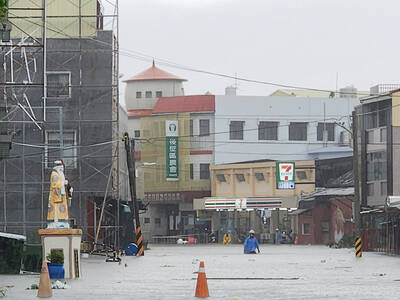The yen strengthened for a fourth week against the US dollar, the longest rally since November, as investors sought a haven on speculation that the economic recovery is slowing.
The Japanese currency gained versus 15 of its 16 major peers as US payrolls fell the first time this year and data showed manufacturing weakened in Europe, China and the US. The euro rose after the European Central Bank (ECB) said it would lend the region’s banks less money than economists forecast, fueling optimism the firms are stronger than expected. US service industries likely slipped last, a report to be released today may show.
“The solid performance of the yen was not surprising,” said Nick Bennenbroek, head of currency strategy at Wells Fargo in New York. “A lot of the US numbers have been disappointing this week — we’re in for slow growth.”
The yen gained 1.7 percent to ¥87.75 per dollar, from ¥89.23 on June 25. It touched ¥86.97, its strongest level since December, on July 1. The Japanese currency rose 0.1 percent versus the euro to ¥110.27. Europe’s shared currency advanced 1.6 percent versus the US dollar to US$1.2566, touching a six-week high of US$1.2612 on Friday.
The euro tumbled to the lowest since 2001 versus Japan’s currency on June 29, ¥107.32, amid concern European banks’ demand for ECB loans when a 12-month facility expired this week would signal weakness in the region’s financial industry.
South Korea’s won and India’s rupee declined the most among Asian currencies this week on concern China’s economic slowdown and Europe’s debt crisis will deter investors from buying emerging-market assets.
The won fell 1.1 percent this week to close at 1,228.75 per US dollar in Seoul. The rupee declined by as much, completing the worst week in more than a month, to 46.79, after a central bank report on June 30 showed the nation’s current-account deficit widened to a record.
The New Taiwan dollar weakened 0.3 percent to NT$32.278 on signs the central bank intervened to help exporters.
Malaysia’s ringgit gained 0.3 percent on Friday and strengthened 0.8 percent this week to 3.2250 per US dollar.
Yuan forwards completed a fourth weekly gain. Twelve-month non-deliverable forwards jumped 0.2 percent to 6.6690 per US dollar and strengthened 0.14 percent in the week. The contracts reflect bets that the yuan will appreciate 1.5 percent in one year.
China’s central bank on Friday set the reference rate for yuan trading at 6.7720, 0.2 percent stronger than the previous day’s fixing.
Thailand’s baht, which was little changed this week, was at 32.41 per US dollar on Friday.
Elsewhere, Indonesia’s rupiah rose 0.1 percent this week to 9,063, for its third weekly gain. The Philippine peso traded at 46.49 against the US dollar and was down 0.1 percent from June 25.

Rainfall is expected to become more widespread and persistent across central and southern Taiwan over the next few days, with the effects of the weather patterns becoming most prominent between last night and tomorrow, the Central Weather Administration (CWA) said yesterday. Independent meteorologist Daniel Wu (吳德榮) said that based on the latest forecast models of the combination of a low-pressure system and southwesterly winds, rainfall and flooding are expected to continue in central and southern Taiwan from today to Sunday. The CWA also warned of flash floods, thunder and lightning, and strong gusts in these areas, as well as landslides and fallen

WAITING GAME: The US has so far only offered a ‘best rate tariff,’ which officials assume is about 15 percent, the same as Japan, a person familiar with the matter said Taiwan and the US have completed “technical consultations” regarding tariffs and a finalized rate is expected to be released soon, Executive Yuan spokeswoman Michelle Lee (李慧芝) told a news conference yesterday, as a 90-day pause on US President Donald Trump’s “reciprocal” tariffs is set to expire today. The two countries have reached a “certain degree of consensus” on issues such as tariffs, nontariff trade barriers, trade facilitation, supply chain resilience and economic security, Lee said. They also discussed opportunities for cooperation, investment and procurement, she said. A joint statement is still being negotiated and would be released once the US government has made

SOUTH CHINA SEA? The Philippine president spoke of adding more classrooms and power plants, while skipping tensions with China over disputed areas Philippine President Ferdinand Marcos Jr yesterday blasted “useless and crumbling” flood control projects in a state of the nation address that focused on domestic issues after a months-long feud with his vice president. Addressing a joint session of congress after days of rain that left at least 31 dead, Marcos repeated his recent warning that the nation faced a climate change-driven “new normal,” while pledging to investigate publicly funded projects that had failed. “Let’s not pretend, the people know that these projects can breed corruption. Kickbacks ... for the boys,” he said, citing houses that were “swept away” by the floods. “Someone has

‘CRUDE’: The potential countermeasure is in response to South Africa renaming Taiwan’s representative offices and the insistence that it move out of Pretoria Taiwan is considering banning exports of semiconductors to South Africa after the latter unilaterally downgraded and changed the names of Taiwan’s two representative offices, the Ministry of Foreign Affairs (MOFA) said yesterday. On Monday last week, the South African Department of International Relations and Cooperation unilaterally released a statement saying that, as of April 1, the Taipei Liaison Offices in Pretoria and Cape Town had been renamed the “Taipei Commercial Office in Johannesburg” and the “Taipei Commercial Office in Cape Town.” Citing UN General Assembly Resolution 2758, it said that South Africa “recognizes the People’s Republic of China (PRC) as the sole